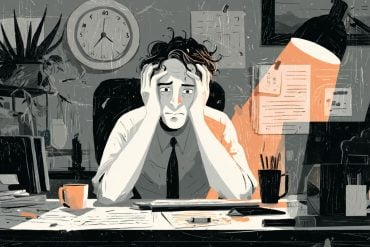Summary: Researchers studied the effects of COVID-19 pandemic stressors on mental health, revealing gender-specific responses.
Anxiety levels in men increased alongside job-related worries, while in women, anxiety rose with concerns about family and friends. Support from friends and family improved the quality of life for women, but this correlation was not found in men.
The study highlights the need to consider social aspects in therapeutic interventions for mental health improvement.
Key Facts:
- Gender-specific anxiety triggers were observed during the COVID-19 pandemic; men’s anxiety was tied to job concerns while women’s anxiety was linked to worries about family and friends.
- Support from friends and family enhanced women’s quality of life during this stressful period, but the same was not observed in men.
- The study underscores the importance of considering gender-specific factors and social aspects in therapeutic interventions for mental health.
Source: University of Würzburg
Does anyone still remember the initial phase of the Corona pandemic in 2020? When shops, restaurants, cinemas, and theatres remained closed. When meetings with friends and relatives were prohibited. When school lessons had to take place at home in the children’s rooms. When there was no question of traveling.
Presently, most people seem to have long forgotten these times. Yet, the various corona measures taken by politicians are likely to have caused enormous stress for many.
The fear for the job, the worry about sick relatives, the nervous strain when parents and children sit together in a small apartment and have to reconcile home office and homeschooling: All this has not remained without effects, as numerous studies show.
The crucial factor is anxiety
How and to what extent have these experiences affected the mental health and quality of life of women and men in the first year of the COVID-19 pandemic? This has been investigated by a research team of the University and the University Hospital Würzburg.
In detail, the scientists were interested in the relationship between worries about the workplace and about other people with a person’s own mental health problems such as anxiety and depression and with their quality of life in general, how these are influenced by the support from friends or at work – and whether the results show differences between men and women.
The findings are unambiguous: in this complex of different variables and influencing factors, anxiety plays a central part.
There are, however, distinct gender-specific differences: “In men, anxiety increases along with concerns about the job, an effect which does not show in women. On the other hand, we were able to register an increase in anxiety levels in women parallel to an increase in their worries about family and friends,” says Grit Hein.
In addition, the study shows that women in such times respond positively to support from friends and family by experiencing enhanced quality of life. In men, this phenomenon did not manifest itself.
Data on the influence of gender were lacking
Grit Hein is Professor of Translational Social Neuroscience at the Clinic and Polyclinic for Psychiatry, Psychosomatics and Psychotherapy at the University Hospital. She and her postdoc Martin Weiß led the study, the results of which have now been published in the journal Scientific Reports.
“In the past, numerous studies have investigated the influence of psychosocial factors such as support from friends and colleagues and financial, professional or personal worries on mental health and the quality of life. Yet, data on whether these correlations are the same for men and women were lacking,” says Grit Hein, explaining the background to the study.
Broadening earlier studies, the Würzburg research team has therefore now examined the influence of these factors in relation to gender.
A study with around 2,900 participants
The team obtained the relevant information from a large group of test subjects: the participants of the so-called STAAB study. This study comprises a cohort of around 5,000 randomly selected volunteers from the general population of Würzburg and originally focused on the development of cardiovascular diseases.
During the COVID-19 pandemic, the program was spontaneously expanded to include the psychosocial impacts of the pandemic, the lockdown, and other side effects.
A total of 2,890 people (1,520 women and 1,370 men) took part in the survey. Their ages ranged from 34 to 85 years, with a median of 60 years. Between June and October 2020, they had to fill out an extensive questionnaire about their mental health.
Among other things, they were asked to provide information about how strongly they felt supported by their social environment, their colleagues and superiors, and whether they had someone with whom they could discuss their problems.
They were also asked to what extent bans on the contact with parents and grandparents burdened them and how much stress they felt at work or at school. Financial problems or worries about them were the subject of further questions.
To evaluate the data, Hein and her team used a special method: the so-called network analysis. “Analyses based on a network approach enable a graphical representation of all variables as individual nodes,” Hein explains.
Thus, it is possible to identify variables that are particularly related to other variables. The network can, for example, show complex relationships between symptoms of different mental disorders and thus explain possible comorbidities.
Results fit traditional gender norms
Grit Hein and Martin Weiß were hardly surprised by the results.
“The observation that men are more strongly associated with work and women more strongly with family and friends can be traced back to traditional gender norms and roles,” Hein explains.
Hence, men usually feel more affected by job insecurity and unemployment, which leads to higher psychological stress. Women, on the other hand, experience more strain when they feel that they are neglecting their family.
It is also plausible that women cope better psychologically when they receive support from friends and family: “This is in line with the traditional female family role, which includes a stronger tendency to maintain close social contacts and to seek social support in order to reduce stress and increase well-being,” says Hein.
Even though these findings are unambiguous, the study leaders point to a number of limitations.
The most important: “Since the COVID-19 pandemic presented a very specific context, it remains to be clarified whether our results are transferable to general pandemic-independent situations.”
One finding, however, is indisputable: “Our results underline the need to consider social aspects in therapeutic interventions in order to improve the mental health of women and men.”
About this stress research news
Author: Esther Knemeyer Pereira
Source: University of Würzburg
Contact: Esther Knemeyer Pereira – University of Würzburg
Image: The image is credited to Neuroscience News
Original Research: Open access.
“Differential network interactions between psychosocial factors, mental health, and health-related quality of life in women and men” by Grit Hein et al. Scientific Reports
Abstract
Differential network interactions between psychosocial factors, mental health, and health-related quality of life in women and men
Psychosocial factors affect mental health and health-related quality of life (HRQL) in a complex manner, yet gender differences in these interactions remain poorly understood. We investigated whether psychosocial factors such as social support and personal and work-related concerns impact mental health and HRQL differentially in women and men during the first year of the COVID-19 pandemic.
Between June and October 2020, the first part of a COVID-19-specific program was conducted within the “Characteristics and Course of Heart Failure Stages A-B and Determinants of Progression (STAAB)” cohort study, a representative age- and gender-stratified sample of the general population of Würzburg, Germany.
Using psychometric networks, we first established the complex relations between personal social support, personal and work-related concerns, and their interactions with anxiety, depression, and HRQL. Second, we tested for gender differences by comparing expected influence, edge weight differences, and stability of the networks.
The network comparison revealed a significant difference in the overall network structure. The male (N = 1370) but not the female network (N = 1520) showed a positive link between work-related concern and anxiety. In both networks, anxiety was the most central variable.
These findings provide further evidence that the complex interplay of psychosocial factors with mental health and HRQL decisively depends on gender.
Our results are relevant for the development of gender-specific interventions to increase resilience in times of pandemic crisis.







